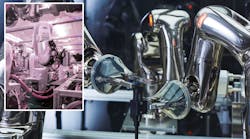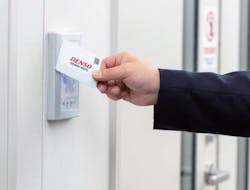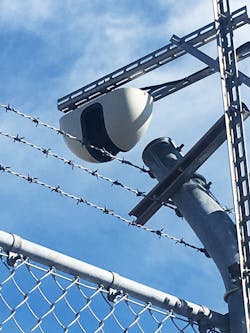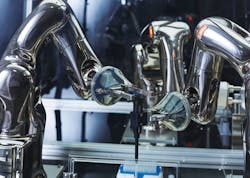What you’ll learn
- Can the ODM meet your specifications, and do they ask the right questions to accomplish that goal?
- Is the ODM reliable with on-time supply?
- Find out if there are hidden costs with a prospective ODM.
In your search for the perfect original design manufacturer (ODM) to meet your security and safety device needs, it may seem like all white-label companies look the same. Choosing the right supplier for security hardware is crucial for your reputation.
Security hardware must be completely reliable—all of the time. Building security, access control, and motion detection are important to your clients, so this kind of equipment must function seamlessly, consistently, and support needs to be immediate (Fig. 1). Furthermore, you may have particular specifications so that the equipment integrates with the systems you have in place.
First, make sure that the security supplier partner has a comprehensive level of experience in delivering all of the security hardware and software needed for your installation. If the ODM has only a partial offering or limited experience, it may be that they aren’t able to make the best recommendation for every application.
You’ll probably have your own list of needs, but it’s beneficial if your supplier partner has experience in a multitude of applications and devices, such as:
- Access control systems
- Proximity sensors
- Motion sensors and motion-tracking software
- Networking
- Controllers and control algorithms
- Electronic lock controllers
- Home security systems
- Commercial and industrial security systems
- Laser sensors
- Biometrics
- Keyless entry systems
- RFID components and RFID system design
- Smartphone integration
- Custom security products and solutions
Many OEM and ODM suppliers will claim to have similar capabilities and offerings. So, if every ODM company claims to have the same experience and expertise, what’s the difference and how can you make the right choice for your business?
The Difference that Makes the Difference
In this article, we cover the top three differences to look for when choosing an ODM for your security hardware needs, and how superior suppliers provide the edge over generic ODMs:
- Ability to meet your specifications and customized needs
- Reliable, on-time supply of equipment
- Transparent cost structure (no hidden costs)
- BONUS: End-to-end support
Many ODM and OEM manufacturers have flexibility in offering a variety of options, but that’s different than coming with an innovative solution to every customer requirement. If the supplier is too focused on providing something similar to what they have already done, it’s likely that it won’t be able to optimize the offering for your specific requirements. That may result in operational issues, customer disappointment, or customer support problems down the line.
It’s wise to get a good understanding of the development team available to the manufacturer, and whether those are specialists in the area of security.
When you interview a new hardware supplier, find out exactly how much access you’ll have to the original development team, and what level of customization they make for your requirements. Many ODMs provide a list of options, but not all of them are able to offer full customization to meet your specifications (Fig. 2). If it sounds like the sales engineer is giving you options rather than personalization, watch out.
Even if you think your needs are generic, experience shows that’s seldom the case. Security-system design and experience in incorporating leading-edge technologies and control algorithms are important elements when fitting the right security hardware and software for your applications (Fig. 3).
Ultimately, the reason you’re outsourcing is because you don’t have (or want to develop) the in-house expertise in security hardware and software. Choosing the right vendor means they will ask the questions that your team doesn’t have the knowledge to ask. If you choose an OEM supplier with a fixed catalog, you’ll end up with solutions that are good enough, but not precise for your needs.
A supplier that can fit your needs as if it were an internal department of your own company will provide a myriad of advantages, helping you stand out among your competition with the right hardware and feature set. Look for engineering teams that can delve deeply into every aspect of equipment use so that when products are designed, they will be precisely what you need to fit your applications and meet your own customers’ requirements.
Reliable, On-Time Supply—Always
Reliable supply of parts depends on a complex chain of events, and the ability to master on-time supply is one of the crucial keys that makes the difference between pleasure and pain when it comes to working with outsourced hardware security suppliers. On-time supply of components is one of the top reasons why companies choose to continue relationships with their ODMs year after year.
Providing on-time supply is difficult because of the myriad of aspects that go into supplying every shipment on time. Before choosing a supplier, get references and find out how they manage the following common pitfalls:
- Raw materials and sub-component supply: Manufacturers depend on other manufacturers. Make sure they’re not single-supplier-dependent for core parts. ODMs that have long-standing relationships with raw material and component suppliers are able to get priority when there are time crunches, avoiding shortages that can hold up the entire production timeline.
- Expertise in expediting shipping requirements, handling documentation, and avoiding surprises at the shipping dock or customs office: Look for an ODM with an excellent track record and pristine reputation for precision shipping and handling procedures. ODMs that have familiarity with customs regulations and flexibility to support multiple incoterms (incoterms comprise a set of 11 internationally recognized rules that define the responsibilities of sellers and buyers) and shipping terms will be able to avoid surprises and other issues that would cause delays.
- Reliable and flexible manufacturing facilities to ensure you can get your high-quality finished goods when you need them: Precision manufacturing backed by significant experience are hallmarks of a best-in-class ODM partner that will be able to provide on-time supply. Utilizing best practices such as Toyota’s just-in-time manufacturing methods and continuous improvement show a commitment to supply-chain quality and optimization.
Just one mistake in the process can result in a delay. Make sure you choose an ODM who won’t make those kinds of mistakes.
No Hidden Costs
An ODM should be working with you in partnership every step of the way, yet many of the manufacturers in the business create their proposals in such a way that customers find themselves ending up with hidden costs or up-charges (Fig. 4). A particular customization might have been discussed in the sales meeting but not included in the proposal, or shipping and customs might end up as surprise add-ons.
Another hidden cost may emerge when there are support problems. ODMs may charge you for defects or returns, or provide only Tier 1 support, up-charging for integration support or other requirements. And that leads to the final topic: customer support.
Bonus: Support is Never Your ProblemMost OEMs supply you the hardware, and some even supply technical support—but only for their hardware. The real focus should be on:
- Whether the product is supported for future engineering changes: Are you able to talk to the original design team?
- Monitoring part obsolescence issues: Does the customer have information on when or whether to do a last-time buy or design in a new part, and can the ODM get the parts you need until the new part is able to be implemented?
Active monitoring is the key to support, so the customer has enough time to make decisions before they become problems. Today, many hardware suppliers are outsourcing Tier 1 and Tier 2 support, meaning the support person you speak to is working for a third party, which is telling.
Conclusions
To summarize, when looking for an ODM for your security hardware and software, consider the following factors:
- Experience and long-term reputation
- Access to new and leading-edge technology
- Ability to truly customize the solution for your needs
- On-time and reliable supply chain
- Transparent pricing structure: no hidden costs
- End-to-end support for the lifetime of the equipment
Choose an ODM partner that doesn’t make problems you have to solve. Rather, the ODM should ensure that your equipment meets your high standards.
Bob Coppenhaver is NA Sales & Marketing Leader at Denso Wave Inc.




